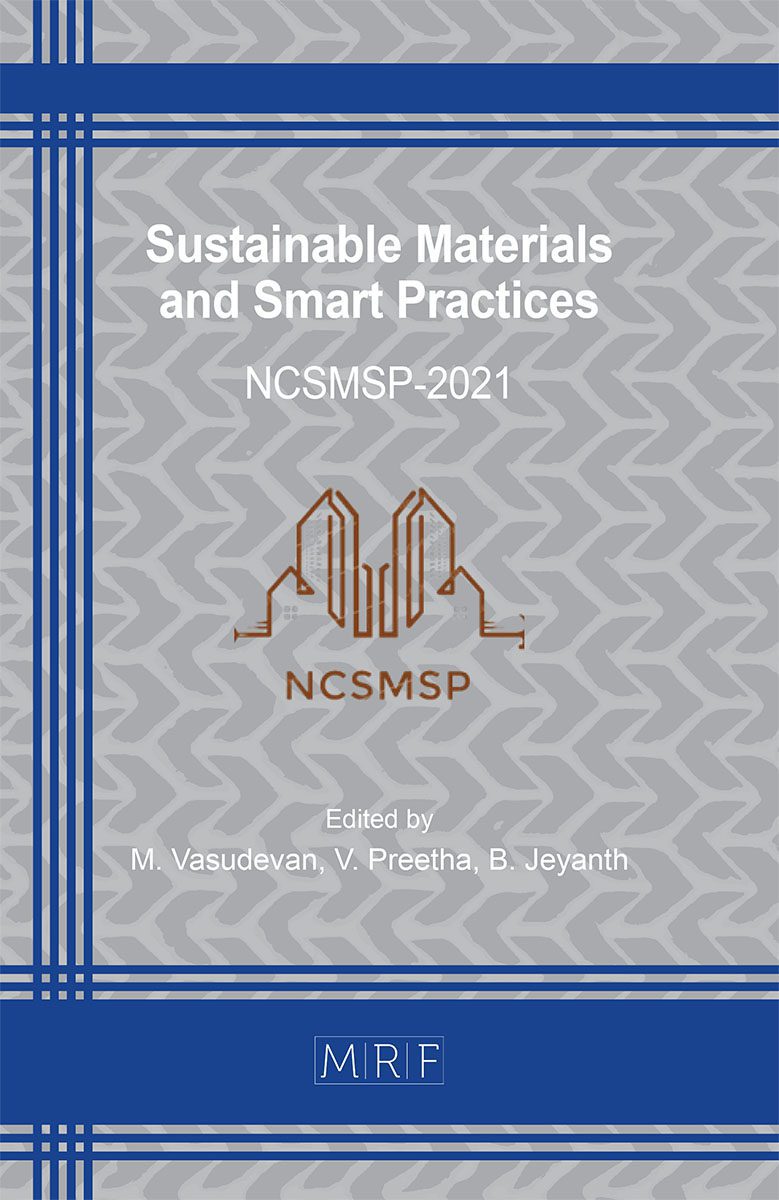Evaluation of Mechanical Properties on Light Weight Concrete by using Silica Fume with M-Sand
V.M. Gnanasundar, T.S. Palanisamy, M. Refak Afrith and B. Pradeepkumar
download PDFAbstract. Light weight Concrete (LWC) is that the building material employed in the development of building utilization the most recent technology to cut back the self-weight of building. Silica fume is added for achieve strength. Silica fume is added in the percentage of 0%, 10%, 15% and 20%. Light weight Concrete prepared by exploitation light weight combinations (pumice stone) or volcanic stone or silicon oxide. Admixture metal powder as associate in nursing air-entraining agent to the conventional combine concrete. Light weight concrete is restricted to sure functions compared to traditional concrete. However, the introduction of light weight concrete offers additional different to the development business, that presently focuses on natural resources. Light weight concrete plays a distinguished role in reducing the density and to extend the thermal insulation. The density of light weight concrete varies from 1440 to 1840kg/m3. By exploitation the sunshine weight concrete it minimizes the earthquake or any environment impact. Generally, light weight concrete has wonderful thermal and sound insulating properties, an honest hearth rating, non-combustible and offers price savings through construction speed and simple handling. Then light weight concrete is great for rooftop deck fixes, support profiles, raised floor chunks, and floor deck overlays. Light weight concrete has a lower temperature move rate than typical weight concrete, bringing about better protection. The principal advantage of lightweight cement is that it is incredibly fast and comparatively easy in construction. Light weight combination particle strength varies with kind and strength. In some cases, compressive strength may be exaggerated by commutation a part of the fine light weight combination with smart quality natural sand.
Keywords
Light Wight Concrete, Density, Silica Fume, M-Sand, Roof
Published online , 8 pages
Copyright © 2022 by the author(s)
Published under license by Materials Research Forum LLC., Millersville PA, USA
Citation: V.M. Gnanasundar, T.S. Palanisamy, M. Refak Afrith and B. Pradeepkumar, Evaluation of Mechanical Properties on Light Weight Concrete by using Silica Fume with M-Sand, Materials Research Proceedings, Vol. 23, pp 68-75, 2022
DOI: https://doi.org/10.21741/9781644901953-9
The article was published as article 9 of the book Sustainable Materials and Smart Practices
![]() Content from this work may be used under the terms of the Creative Commons Attribution 3.0 licence. Any further distribution of this work must maintain attribution to the author(s) and the title of the work, journal citation and DOI.
Content from this work may be used under the terms of the Creative Commons Attribution 3.0 licence. Any further distribution of this work must maintain attribution to the author(s) and the title of the work, journal citation and DOI.
References
[1] ACI 116R. Cements and Concrete Terminologies. American Concrete Institute (2005).
[2] Siddique, R. & M.I. Khan. Supplementary Cementing Material. Springer Heidelberg (2011). https://doi.org/10.1007/978-3-642-17866-5
[3] ACI Committee 234. Guide for the use of silica fume in concrete (ACI 234R). ACI Materials Journal 92(4): 437- 440 (1995). https://doi.org/10.14359/978
[4] Aitcin, P.C. & P. Laplante. Long-term compressive strength of silica fume concrete. Journal of Materials in Civil Engineering 2(3): 164-170 (1990). https://doi.org/10.1061/(ASCE)0899-1561(1990)2:3(164)
[5] Newmann, J. & B.S. Choo. Advanced Concrete Technology Constituent Materials. Elsevier Linacre House, Jordan Hill, Oxford (2003).
[6] Katkhuda, H., B. Hanayneh, & N. Shatarat. Influence of Silica Fume on High Strength Lightweight Concrete. World Academy of Science, Engineering and Technology 3(10): 757-764 (2009).
[7] Bhanja, S. & B. Sengupta. Influence of silica fume on the tensile strength of concrete. Cement and Concrete Research 35(4): 743-747 (2005). https://doi.org/10.1016/j.cemconres.2004.05.024
[8] Ganesh, B.K. & P.V.S. Prakash. Efficiency of silica fume in concrete. Cement & Concrete Research 25(6): 1273-1283 (1995). https://doi.org/10.1016/0008-8846(95)00120-2
[9] Detwiler, R.J. & P.K. Mehta. Chemical and Physical Effects of Silica Fume on the Mechanical Behaviour of Concrete. ACI Materials Journal. 86(6): 609-614 (1989). https://doi.org/10.14359/2281
[10] Khedr, S.A. & M.N. Abou-Zeid. Characteristics of Silica-Fume Concrete. Journal of Materials in Civil Engineering, ASCE 6(3): 357-375 (1994). https://doi.org/10.1061/(ASCE)0899-1561(1994)6:3(357)
[11] Bhanja, S. & B. Sengupta. Optimum Silica Fume Content and its Mode of Action on Concrete. ACI Materials Journal 100(5): 407-412 (2003). https://doi.org/10.14359/12816
[12] Ajileye, V.F. Investigations on M. S. (S. F.) As Partial Cement Replacement in Concrete. Global Journal of Researches in Engineering Civil and Structural Engineering 12(1): (2012).
[13] Amudhavalli, N., & K.J. Mathew. Effect of silica fume on strength and durability parameters of concrete, International Journal of Engineering Sciences & Emerging Technologies 3(1): 28-35 (2012).
[14] Sabale, V.D., M.D. Borgave, & S.D. Shinde. Study the Effect of Addition of Silica Fume on Properties of High Strength Concrete. International Journal of Engineering Research & Technology 3(1): 267-270 (2014).































